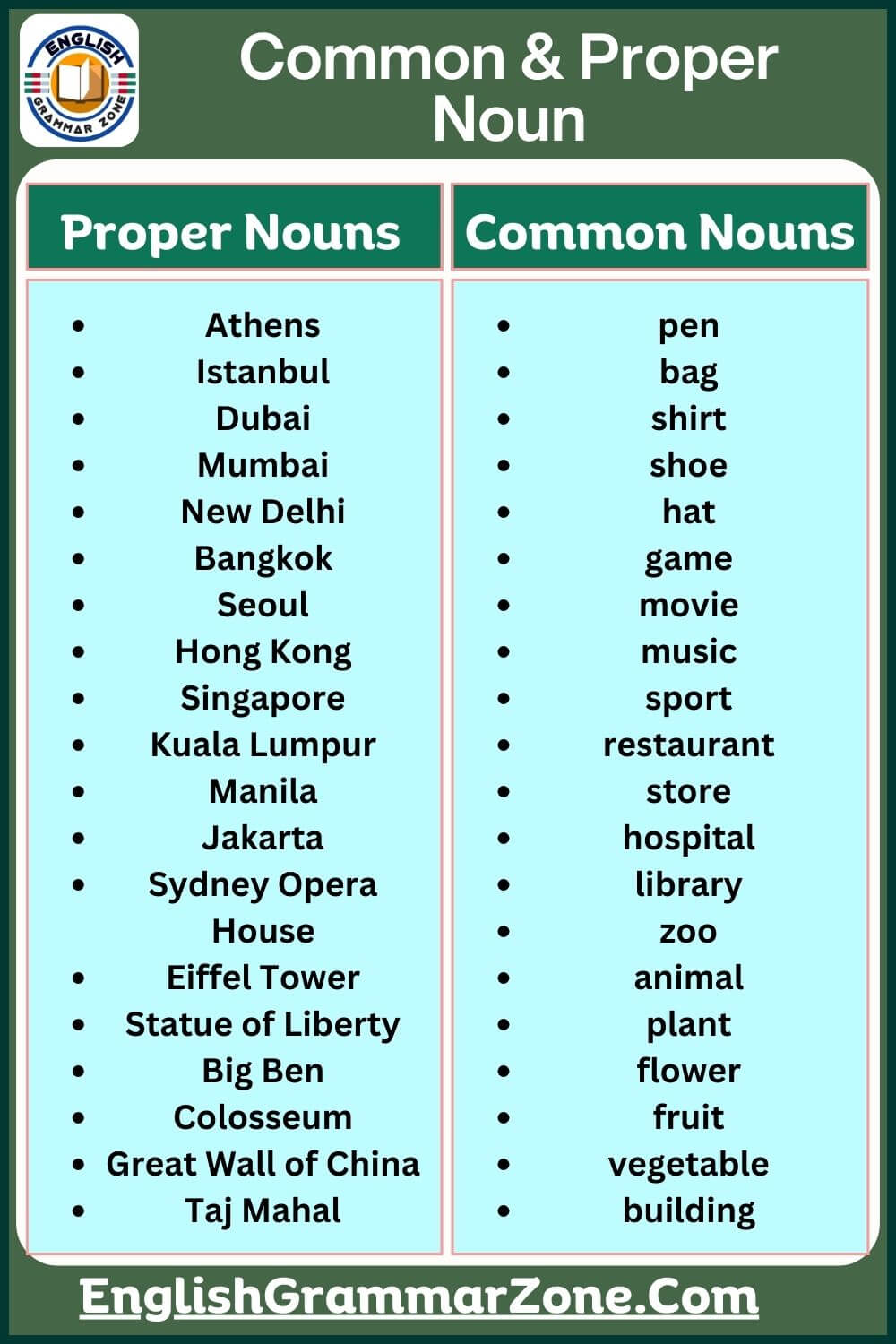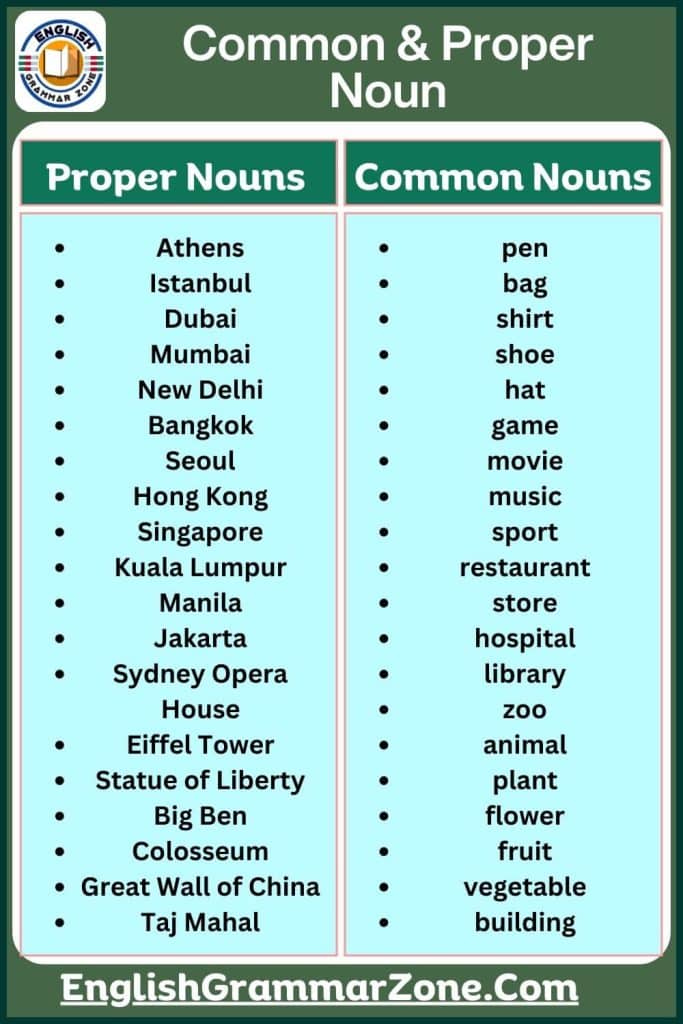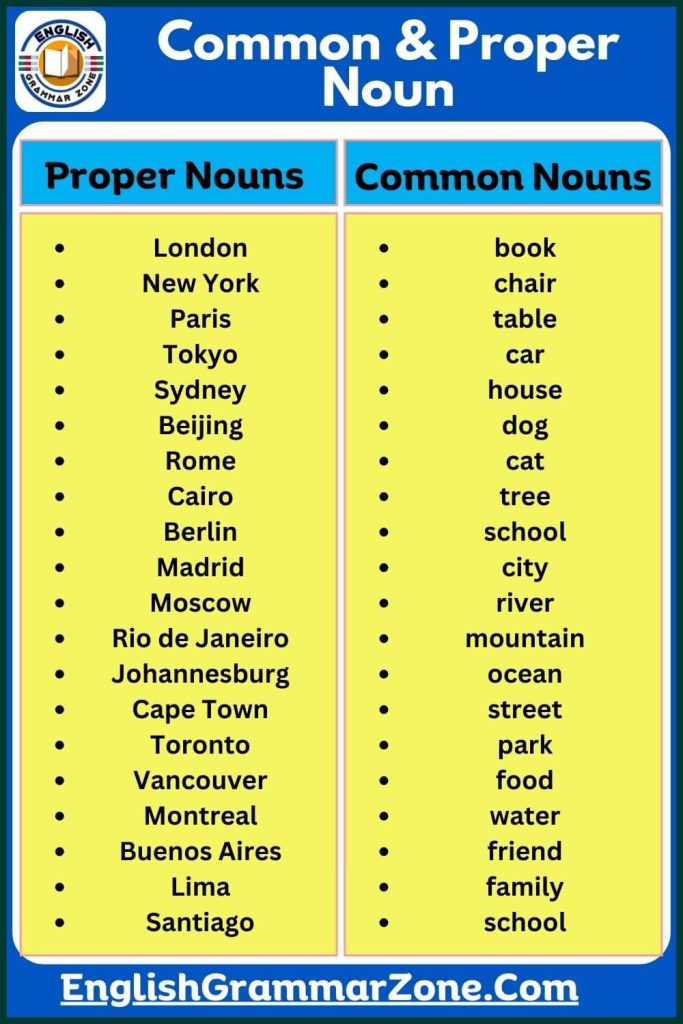In the English language, nouns are one of the most important parts of speech. Nouns are words that name people, places, things, or ideas. There are different types of nouns, but two of the most common categories are common noun and proper noun. Understanding the difference between these two types of nouns is essential for improving your writing and speaking skills.
A common noun refers to a general name for a person, place, thing, or idea. These are not specific names and are used to refer to things in a broad sense. For example, “dog,” “city,” and “book” are all common nouns because they refer to a general category of things, not a specific instance. On the other hand, a proper noun refers to the specific name of a person, place, or thing. Proper nouns are always capitalized to indicate their importance as unique identifiers. For example, “John,” “Paris,” and “The Bible” are all proper nouns because they name specific individuals, places, or things.
By understanding the difference between common nouns and proper nouns, you can improve your grammar, writing, and communication skills. Let’s explore both types of nouns in more detail and answer some frequently asked questions about them.
Common Noun and Proper noun
Common Noun and Proper noun
100 Proper Nouns
- London
- New York
- Paris
- Tokyo
- Sydney
- Beijing
- Rome
- Cairo
- Berlin
- Madrid
- Moscow
- Rio de Janeiro
- Johannesburg
- Cape Town
- Toronto
- Vancouver
- Montreal
- Buenos Aires
- Lima
- Santiago
- Athens
- Istanbul
- Dubai
- Mumbai
- New Delhi
- Bangkok
- Seoul
- Hong Kong
- Singapore
- Kuala Lumpur
- Manila
- Jakarta
- Sydney Opera House
- Eiffel Tower
- Statue of Liberty
- Big Ben
- Colosseum
- Great Wall of China
- Taj Mahal
- Christ the Redeemer
- Mount Everest
- Nile River
- Amazon Rainforest
- Victoria Falls
- Grand Canyon
- Yellowstone National Park
- Niagara Falls
- Mount Fuji
- Sahara Desert
- Great Barrier Reef
- Shakespeare
- Einstein
- Mozart
- Beethoven
- Van Gogh
- Picasso
- Leonardo da Vinci
- Michelangelo
- Rembrandt
- Monet
- Apple
- Microsoft
- Amazon
- Netflix
- Disney
- Tesla
- Coca-Cola
- Nike
- Adidas
- Ferrari
- Lamborghini
- Rolex
- Harvard University
- Oxford University
- Stanford University
- MIT
- Yale University
- Cambridge University
- London Eye
- Sydney Harbour Bridge
- Times Square
- Hollywood
- Wall Street
- Silicon Valley
- Mount Kilimanjaro
- Table Mountain
- Blue Ridge Mountains
- Rocky Mountains
- Andes Mountains
- Sydney Opera House
- Golden Gate Bridge
- Tower Bridge
- Buckingham Palace
- White House
- Kremlin
- Vatican City
- United Nations
- NATO
100 Common Nouns
- book
- chair
- table
- car
- house
- dog
- cat
- tree
- school
- city
- river
- mountain
- ocean
- street
- park
- food
- water
- friend
- family
- school
- teacher
- student
- computer
- phone
- pen
- bag
- shirt
- shoe
- hat
- game
- movie
- music
- sport
- restaurant
- store
- hospital
- library
- zoo
- animal
- plant
- flower
- fruit
- vegetable
- building
- door
- window
- bed
- desk
- sofa
- television
- radio
- camera
- photograph
- picture
- clock
- watch
- money
- bank
- post office
- train
- bus
- bicycle
- airport
- hotel
- beach
- mountain
- forest
- river
- lake
- island
- sun
- moon
- star
- cloud
- rain
- snow
- wind
- temperature
- weather
- season
- holiday
- festival
- concert
- party
- event
- ceremony
- tradition
- culture
- language
- country
- state
- town
- village
- neighborhood
- farm
- factory
- office
- workshop
- gym
- park
Common Noun and Proper noun
Frequently Asked Questions about Common Noun and Proper Noun
1. What is the difference between a common noun and a proper noun?
The main difference between a common noun and a proper noun is that common nouns name general items or things, while proper nouns name specific, unique items.
- Common nouns refer to a general category or class of things. Examples include “school,” “car,” “apple,” or “city.”
- Proper nouns are specific names of people, places, or things, and they are always capitalized. Examples include “Harvard University,” “Toyota,” “Golden Delicious,” and “New York.”
2. Are common nouns always lowercase?
Yes, common nouns are usually written in lowercase unless they appear at the beginning of a sentence or in a title. For example, “dog” is a common noun, but if it’s at the start of a sentence, it would be capitalized: “The dog ran fast.”
3. Can a proper noun be used as a common noun?
Yes, sometimes proper nouns can be used as common nouns. This typically happens when a specific brand name or place name becomes so well-known that it is used to refer to something in a general way. For example, “Kleenex” is a brand name (proper noun), but people often use it to refer to any tissue (common noun). Similarly, “Google” is a proper noun, but people sometimes use it as a verb meaning to search for something online.
4. What are some examples of common nouns and proper nouns?
Here are a few examples to help you understand the difference between common nouns and proper nouns:
- Common Noun: teacher, restaurant, country, book, car
- Proper Noun: Mr. Smith, McDonald’s, France, Harry Potter, Ford
As you can see, common nouns are general terms, while proper nouns are specific names or titles.
5. Do common nouns have to be capitalized?
No, common nouns are not capitalized unless they are at the start of a sentence or part of a title. For instance, in the sentence “I love my dog,” the word “dog” is a common noun and should not be capitalized. However, if it’s the first word of the sentence, it would be: “Dog is my favorite animal.”
6. Can a proper noun become a common noun over time?
Yes, some proper nouns may evolve into common nouns if they are used widely and come to represent a general item rather than a specific one. For instance, the brand name “Band-Aid” is a proper noun, but people often use it to refer to any adhesive bandage, regardless of brand. Similarly, “Xerox” originally referred to a specific brand, but now it can also mean to photocopy something.
7. Why is it important to know the difference between common and proper nouns?
Knowing the difference between common nouns and proper nouns is essential for improving your writing and communication. Proper use of capitalization helps readers understand the importance of certain words in a sentence. Additionally, using the correct noun type makes your writing clearer and more precise. It also helps in sentence structure, especially when identifying subjects or objects.


